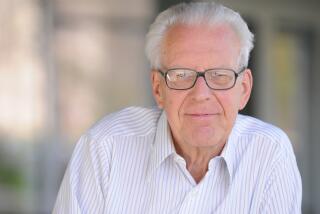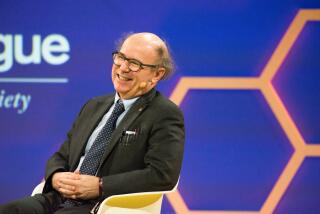‘The Particle at the End of the Universe’ gets real
- Share via
The Particle at the End of the Universe
How the Hunt for the Higgs Boson Leads Us to the Edge of a New World
Sean Carroll
Dutton: 352 pp., $27.95
On July 4, 2012, at the CERN laboratory in Geneva — home to the massive particle accelerator known as the Large Hadron Collider, or LHC — two groups of physicists announced the discovery of a new elementary particle, the Higgs boson. Widely known as “the God particle,” the Higgs is important, on the most basic level, for giving other subatomic particles mass.
“The Higgs particle arises from a field pervading space, known as the Higgs field,” explains Caltech physicist Sean Carroll in “The Particle at the End of the Universe: How the Hunt for the Higgs Boson Leads Us to the Edge of a New World.” “Everything in the known universe, as it travels through space, moves through the Higgs field; it’s always there lurking invisibly in the background.”
As to why this matters, Carroll points out that “without the Higgs, electrons and quarks would be massless, just like photons, the particles of light. They would move at the speed of light themselves, and it would be impossible to form atoms and molecules much less life as we know it.... Without it, the world would be an utterly different place.”
PHOTOS: The search for the elusive Higgs boson
“The Particle at the End of the Universe” is a scientific detective story, the saga of the search for the Higgs. Like all such stories, it’s driven by a fundamental, yet elusive, mystery: What is the nature of the universe? That, Carroll believes, is both a matter of philosophy and curiosity, going back to Aristotle on the one hand, and on the other, to our ongoing fascination with how reality works.
“Passion for science,” he writes late in the book, “derives from an aesthetic sensibility, not a practical one. We discover something new about the world, and that lets us better appreciate its beauty.”
This is a key idea, for it suggests a way of thinking about theoretical physics — even for the nonscientifically minded — as the search for “an elegant mechanism … like being able to read poetry in the original language, instead of being stuck with mediocre translation.”
To elaborate, Carroll gives a lot of context: facts and figures, yes, but also passion, characters, history. He introduces physicists such as Peter Higgs, from whom the Higgs boson gets its name, as well as François Englert, Robert Brout, Carl Richard Hagen, Gerald Guralnik and Tom Kibble, all of whom did groundbreaking work in the early 1960s positing the existence of such a particle — postulations that took nearly half a century to bear out.
The book also traces the politics and the economics of the LHC, built with international money and participation. “Over and over again,” Carroll writes, “physicists I talked to while writing this book spoke … about how CERN could serve as a model for large-scale international collaboration.” One tells him, “What’s amazing to me is that we have people from 70 countries around the world working — together. Palestinians and Israelis working side-by-side, Iranians and Iraqi scientists work together — such collaboration in the pursuit of big science shouldn’t be overlooked.”
At the same time, Carroll grounds “The Particle at the End of the Universe” in the personal, using his childhood interest in dinosaurs (“I never seriously considered paleontology as a career, but every scientist I know secretly agrees that dinosaurs are the epitome of cool”) to frame what he calls “the quest for awesome — that literal awe that you feel when you understand something profound for the first time.”
For Carroll, the point is to make his material accessible, to open subatomic physics to an audience that might be daunted otherwise. In that sense, I may be his ideal reader, interested in the concepts but intimidated by the calculations and the math.
And yet, it’s Carroll’s status as a physicist — an insider, as it were — that gives “The Particle at the End of the Universe” its necessary heft. Were he a journalist or a science writer, he might tend toward the metaphorical in explaining the Higgs project. But even though he’s not averse to framing comparisons (“If you’re trying to explain subatomic phenomena,” he admits, “the only way to get compelling images is to reach for an analogy,”) he doesn’t want to oversimplify.
That’s his issue with the term “God particle,” which is really just a metaphor gone wrong. This flashy phrase, coined by Nobel laureate Leon Lederman, refers to “the singular role of the Higgs: it’s the final part of the Standard Model of particle physics,” which “explains everything we experience in our everyday lives … [i]t’s the full theory of immediately discernible reality.”
Without the Higgs, there’d be no friction, no essential tension, nothing for those quarks, neutrinos and electrons to push against. In that sense, perhaps, it may be most accurate to call the Higgs boson an animating force, one that disrupts, or breaks, certain symmetries between particles and helps create a differentiated world.
Now I’m the one oversimplifying. But the idea is that the Higgs boson (or more accurately, the Higgs field) represents a subatomic spark. For Carroll, that’s important because it brings us closer to understanding the universe in which we live.
PHOTOS: The search for the elusive Higgs boson
“We are part of the universe that has developed a remarkable ability,” he observes, “we can hold an image of the universe in our minds. We are matter contemplating itself.”
This is as close as the book gets to metaphysics, but it’s a stunning statement just the same. What he’s suggesting, after all, is science as a form of heightened self-discovery, in which the universe we study is ourselves.
Or, as Italian physicist Fabiola Gianotti, a central player in the Higgs discovery, puts it: “Fundamental knowledge is a little bit like art. It’s something very much related to the spirit, the soul, the brain of men and women as clever beings.”
More to Read
Sign up for our Book Club newsletter
Get the latest news, events and more from the Los Angeles Times Book Club, and help us get L.A. reading and talking.
You may occasionally receive promotional content from the Los Angeles Times.








